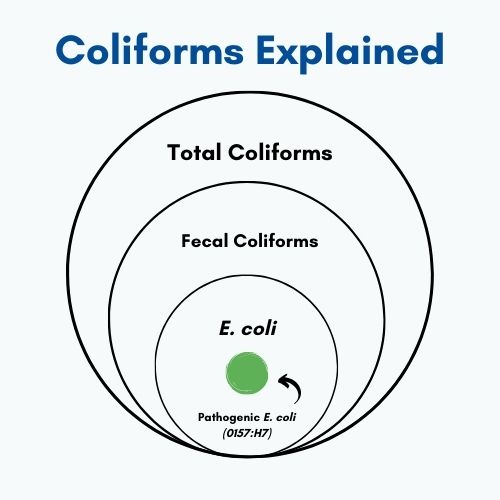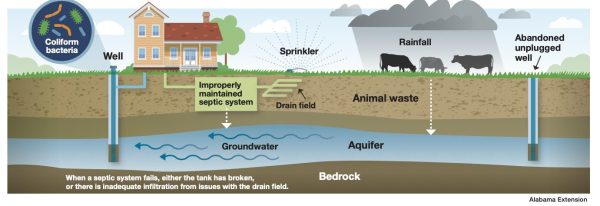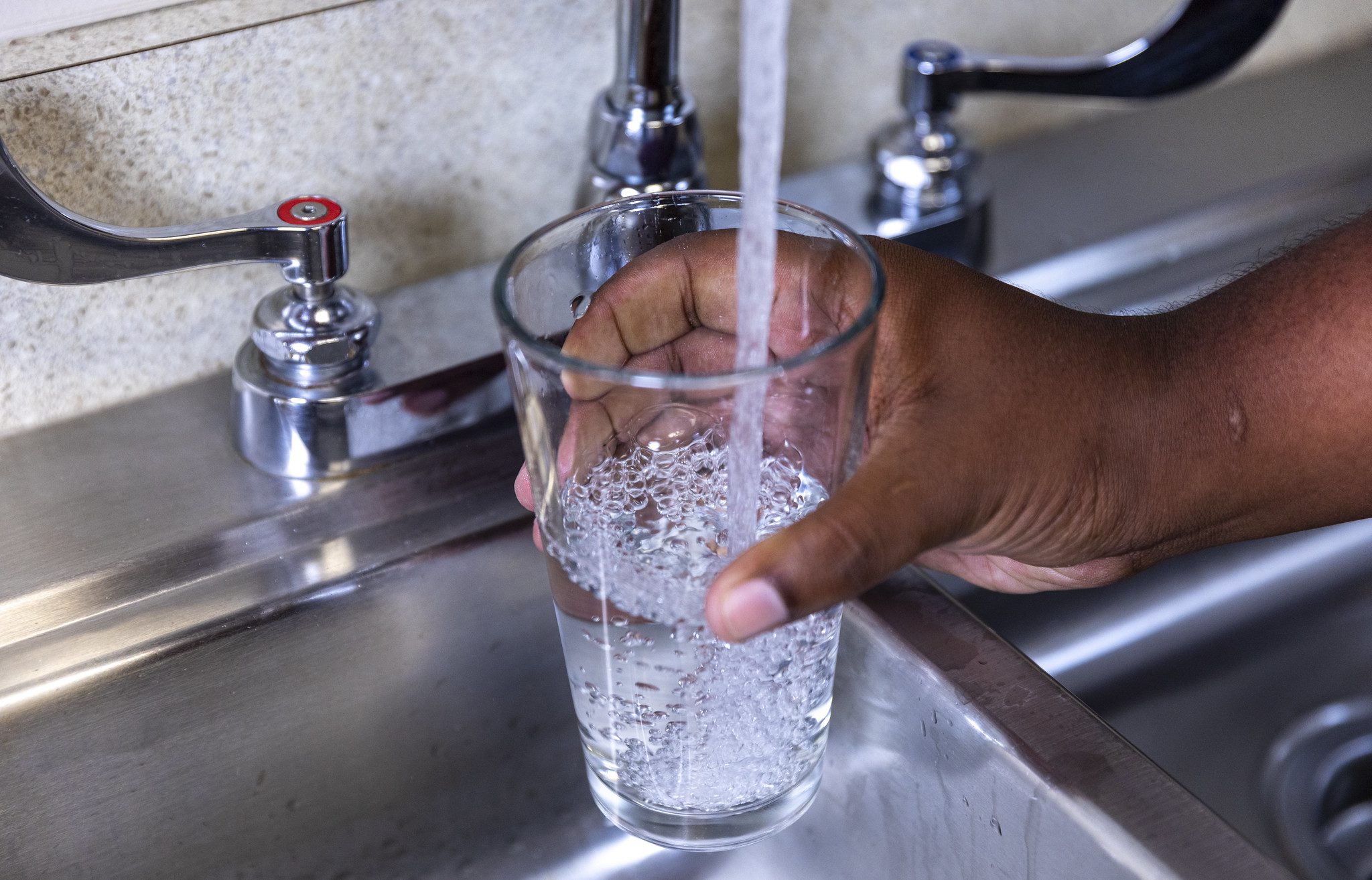Fish & Water

Individuals who drink water from a private well should have the water tested at least once a year for contamination.
Bacterial Contaminants
Drinking contaminated water can expose humans to a variety of harmful pollutants and pathogens. Bacterial contamination presents a great health risk to private water supply users by causing diseases such as typhoid, dysentery, hepatitis, and more. Private wells can be contaminated by bacteria from many sources. Contamination is most seen in shallow wells, poorly constructed or maintained wells, and areas with porous soils and fractured bedrock.
What Are Coliform Bacteria?
Generally, coliforms belong to a group of bacteria that are not harmful to humans and are naturally present in the environment. These bacteria are abundant in soils, surface water, and vegetation and are used as an indicator that other potentially harmful, fecal coliform bacteria (such as E. coli) may be present. While many coliform bacteria may be harmless, some, such as pathogenic E. coli, may cause mild to serious illness. The presence of coliform bacteria indicates that there is a pathway for other pathogens and contaminants to enter the well water system. It is important to find the source of contamination and resolve the problem.
What Are Fecal Coliform Bacteria?

Figure 1. Fecal coliforms are a subset of total coliform bacteria. Escherichia coli (E. coli) is a subset of fecal coliform bacteria. Several strains of E. coli exist, and some, such as E. coli O157:H7, can cause serious illness.
Fecal coliform bacteria are a subset of total coliform bacteria (figure 1), which may be found in the digestive systems of humans and warm-blooded animals. Because the origins of fecal coliforms are more specific than the origins of the total coliform group, fecal coliforms are considered a more accurate indication of animal or human waste presence in the water. The presence of fecal coliform bacteria signals a greater risk that harmful pathogens may be present.
What Is E. coli?
Escherichia coli (E. coli), a subset of fecal coliform bacteria, is the predominant fecal coliform bacteria found in the gut of warm-blooded animals. Several strains of E. coli bacteria exist, and while some are harmless, some strains, such as E. coli O157:H7, can cause serious illness. A positive E. coli result almost always indicates that human or animal fecal waste is entering the water supply. If coliform bacteria are detected, but E. coli is absent, the contamination is likely from soil or vegetation. Therefore, the presence of coliform bacteria provides a warning that more serious contamination may also be present.
How Do These Bacteria Enter Waterways?
Coliform bacteria are commonly found in soils, surface water, and plants. They can also be present as fecal coliform in the intestines of warm-blooded animals and humans. Most coliform bacteria enter streams by direct deposition of fecal waste in the water and runoff from areas with high animal concentrations. Surface water runoff can transport bacteria from agricultural fields, improperly maintained wastewater systems, and places where wildlife concentrate, such as bird-roosting areas. When a well is properly constructed and maintained, the water that falls to the surface as precipitation infiltrates into the ground, taking quite some time (months, years, decades) to move through layers of sediment and rock to become groundwater. During this process, bacteria and other microorganisms die off, which is why deeper groundwater is often used rather than surface or near- surface water.
Water wells may become contaminated with bacteria for one or more of the following reasons (figure 2):
- A source of contamination is near the well and the casing is damaged or cracked or does not extend deep enough to ensure that bacteria have been adequately filtered out by the soil.
- The well is in a depression that collects surface runoff or the ground slopes toward the well casing instead of away from it.
- A malfunctioning septic system is located near the well.
- The well was constructed using poor sanitary or construction practices, such as a pump being left on the ground and the well not being disinfected afterward.
- The aquifer may be a highly fractured formation or coarse gravel or sand deposit that does not adequately filter contaminants percolating down from the surface into the aquifer.
- The well cap is not a sealed, sanitary well cap, or it is loosely installed and allows insects, spiders, and small animals to enter the well.

Figure 2. A number of factors can contribute to a well becoming contaminated with bacteria. (Originally created by the Michigan Department of Health and Human Services.)
Contaminated surface water enters a well in one of the following ways:
- Dug wells with poorly sealed stone or brick or wells with unsealed covers that allow surface water to get into the well.
- Casing improperly sealed through a shallow, unconsolidated bedrock formation.
- Casing does not extend past the flood line, allowing surface water to enter.
- Corroded or old well casing allows contaminated water to directly infiltrate the system.
What Are Health Concerns Associated with Coliform Bacteria?
Most coliform bacteria are not harmful. However, some harmful strains such as E.coli O157:H7 can lead to illness. Acute (short-term) exposure to harmful bacteria may result in an upset stomach, fever, vomiting, or diarrhea. Prolonged exposure to harmful bacteria can become serious and lead to long-term health implications.
What Are Indicators of Bacteria in Drinking Water?
Testing by a laboratory is the best way to know if water contains coliform bacteria. It may be difficult to detect bacterial contamination in well water because water contaminated with bacteria will pass a “sniff test.” It will have a normal smell, taste, and appearance, despite being harmful to drink. If a family member or visiting guest has recently become ill after drinking from a private well source, the water may be contaminated.
Can You Test for All Microorganisms?
Testing is usually done for three different types of indicator bacteria: total coliform, fecal coliform, and E. coli. The presence of these indicator bacteria may indicate more dangerous microorganisms including other bacteria and parasites such as cryptosporidium and giardia. Testing drinking water for all possible pathogens is complex, time consuming, and expensive. Below are guidelines on what to do if well water tests positive for indicator bacteria.
When Should You Test for Coliform Bacteria?
At a minimum, well water should be tested each year for total coliform bacteria, nitrates, lead, total dissolved solids, and pH levels. The best times of the year to test well water are when it is most likely to be unsafe, usually following a period of heavy rain. Coliform bacteria thrive in warm temperatures, so bacterial abundance is usually highest during warmer, wetter conditions. Bacteria presence may vary throughout the year based on the temperature and weather of the region. These variations should be considered when testing well water supplies for bacterial contamination.
Well water should also be tested under the following conditions:
- At least once a year for all wells in service
- When a new well is constructed
- When an existing well is returned to service
- If a neighbor is experiencing water contamination
- If there is a sudden change in the color, taste, or odor of the water
- If a family member or guests have gastrointestinal issues or illness
- When any component of the water system is opened for repair
- When flood waters or surface runoff inundates the well
- When contamination is suspected
- When a laboratory test indicates nitrate-nitrogen concentrations above 10 milligrams per liter (ppm)
Testing Water for Coliform Bacteria
The most common water tests for bacteria are for total coliform bacteria and E. coli. These tests are offered by the Alabama Department of Public Health as well as by some certified private laboratories, and may range in price from $10.00 to $100.00). A list of laboratories offering bacterial testing is available on the Alabama Extension website, Private Well Program. Take samples in a bottle issued by the testing entity and follow provided instructions carefully.
Interpreting Results of a Bacterial Test
Under the Safe Drinking Water Act, the EPA regulates public water utilities and sets standards for drinking water quality. While private well owners are not required to follow the Safe Drinking Water Act guidelines, the acceptable contaminant levels established by this Act can assist well users in evaluating well water quality for their home systems. A general report will indicate whether coliform bacteria are present in the water. This information is conveyed on the lab test form as coliform bacteria being “ABSENT” or “PRESENT.” Some labs may provide quantified results as MPN (Most Probable Number) or CFU (Colony Forming Unit).
What Should I Do if My Sample Tests Positive for Coliform Bacteria?
If a well water sample tests positive for total coliform but negative for fecal coliform or E. coli, an immediate health concern may not be present but further investigation should be done. If the well water tests positive for total coliforms, the water should not be consumed. Use bottled water for drinking and cooking until coliform presence is confirmed by a second test. If bottled water is unavailable, boil water following recommendations from the Water Systems Council. Test results should be confirmed through additional testing. False-positive tests are a common issue attributed to improper sampling methods. Samples should be retaken and tested again with careful attention to proper handling guidelines. Well owners should also ask themselves these questions:
- Is the well cap or seal on tightly?
- Is water standing near the well?
- Does the casing extend one foot from the ground?
- Is the well in a depression or pit?
- Has the pump been removed recently?
- Was the container contaminated during sampling?
If the well water continues to test positive for coliform bacteria, the next step is to identify the source of contamination. If a water quality test result is indicating bacteria presence, there is likely a contamination pathway between the source of bacteria (surface water, animal waste, faulty septic system) and the drinking water. Contaminants may enter wells through cracked casing or a damaged cap, so make sure that the wellhead area is properly maintained. Visually inspect the well and well casing to check for cracks, poor sealing, etc., and contact a professional if any damaged areas are found. Treatment measures should be taken to address the bacterial contamination of the drinking water.
Treating Bacterial Contamination
If water quality test results show bacterial contamination, the source of contamination should be determined and remediated as soon as possible. This eliminates the risk of continued contamination by this source. An immediate remedy for bacterial contamination of a well is to disinfect or shock-chlorinate the well with chlorine bleach. Shock chlorination is a temporary measure, and bacteria will likely return if the source of the contamination is not addressed.
Shock chlorination can be used to disinfect a well by introducing a high concentration of chlorine to water for at least 12 to 24 hours. Concentrated chlorine solutions can be dangerous, so wear personal protective equipment (gloves, goggles, and a protective apron) when handling them. The bleach solution is mixed based on the volume of water present in the water system, so check the depth, diameter, and water level of the well. To reduce the risk of exposure to hazardous chemicals and to protect the well components, a licensed well driller or pump installer should disinfect the well.
See the Alabama Department of Environmental Management website for a list of licensed well drillers in Alabama.
Well owners wishing to conduct shock chlorination may refer to either the Water Systems Council information sheets or instructions in the Alabama Extension publication “Flooded Wells: Shock Chlorination” (ANR- 2512). For recurring bacteria problems, identify the source and implement continuous disinfection.
Continuous chlorination systems can be attached after the well head pump. These will inject a chlorine solution or dry powder into the water ahead of the storage tank. Sediment filters are recommended with these systems.
The effectiveness of chlorination depends on many factors:
- Contact time is the amount of time water is in contact with chlorine.
- Water quality refers to how untreated water can affect chlorination, as some contaminants, such as iron, manganese, hydrogen sulfide, ammonia, and organic materials, or how other characteristics of the water, such as pH, can affect the chlorine and make it unavailable for the targeted contaminants. This can be addressed by pretreatment.
- Water temperature and pH can affect chlorination. Ideal conditions are considered high temperatures with low pH. Water may also contain some natural organic chemicals from the breakdown of plants and leaves, which can combine with chlorine to form chemicals called trihalomethanes (THMs). Activated carbon filters can be used to remove THMs.
Ultraviolet (UV) light is effective in treating bacterial contamination in well water systems. Unlike chlorination, UV radiation treatment can be fast without adding anything to the water or causing additional taste or odor. Water is exposed through UV radiation as it flows over a glass sleeve encasing a UV light bulb. Because the pathogens need to be exposed to UV light, suspended particles in the untreated water may interfere with treatment. Therefore, UV treatment is often paired with a filtration method and should be the last treatment used in a sequence. Water with high amounts of calcium and magnesium may also coat the glass sleeve with a scale, so the unit should be routinely cleaned. Manufacturers should provide information on cleaning the system and replacing bulbs.
Ozone is a highly reactive gas commonly used in water treatment to kill bacteria and some viruses. This method of treatment is relatively expensive and may be useful where multiple water quality problems must be addressed.
Boiling water for about 1 minute kills most bacteria. This method can be used during emergencies and can only treat small amounts of water at a time. It is not a long- term or continuous option for water supply disinfection.
Bacterial Contaminants at a Glance
Symptoms: Intestinal illness, positive test result for bacterial contamination
Source of the Problem: Bacteria entering a well through surface water contaminated with surface water and/or waste, wastes seeping into groundwater, cross- contamination while sampling
Possible Treatments: Shock chlorination and well maintenance, ultraviolet light treatment, chlorination, ozonation
Prevention: Properly installed, sealed, and maintained well and well cap, wells located up-gradient of septic systems
Additional Resources
- Virginia Cooperative Extension: Virginia Household Water Quality Program: Bacteria and Other Microorganisms in Household Water
- Penn State Extension: Coliform Bacteria
- EPA Emergency Disinfection of Drinking Water
- EPA Addressing Total Coliform Positive or E. coli Positive Sample Results in EPA Region 8
- UGA Extension: Coliform Bacteria in Your Water
- Mississippi State University Extension: What to Do about Coliform Bacteria in Well Water
- Wisconsin Department of Natural Resources: Bacteriological Contamination of Drinking Water Wells
- Washington State Department of Health: Coliform Bacteria in Drinking Water
- Water Systems Council
- Michigan Department of Health and Human Services: Coliform Bacteria in Drinking Water for Well Owners
 Jessica Curl, Administrator, Outreach Programs, Aquatic Resources, Alabama Private Well Program Coordinator, Auburn University
Jessica Curl, Administrator, Outreach Programs, Aquatic Resources, Alabama Private Well Program Coordinator, Auburn University
New January 2022, Coliform Bacteria in Well Water, ANR-2779

